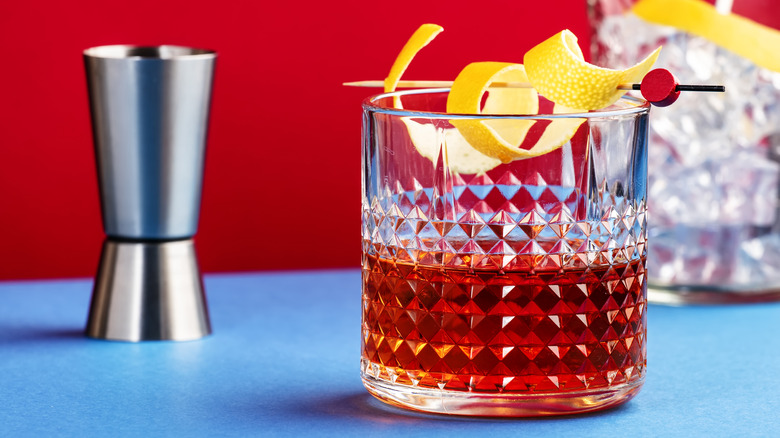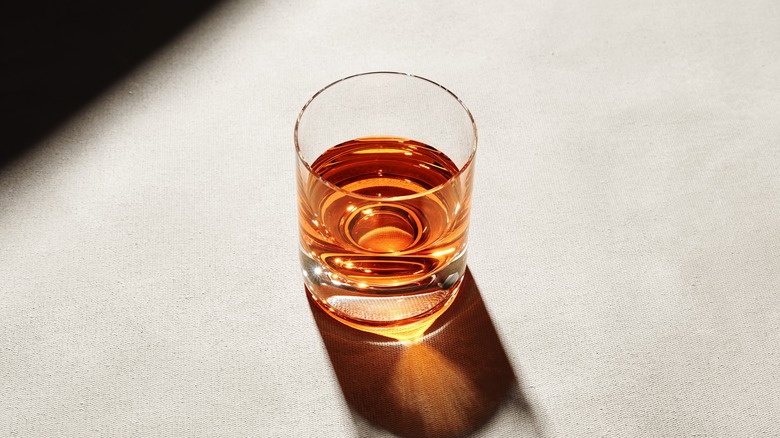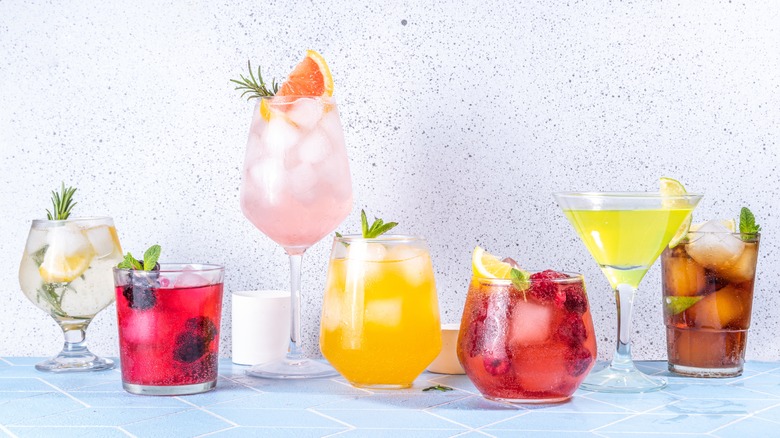What Does It Mean To Order A Drink 'Down'?
Learning how to order with confidence at a bar is a rite of passage for many. Yet somehow, no matter how much you study or how frequently you chat with your bartender, there's always more to discover. One word to add to your lexicon is "down."
If you're wondering if this term relates to ordering a drink "up," you'd be on the right track. Despite sounding like opposites, asking for your drink "up" or "down" actually sends similar signals to your bartender. Ordering a cocktail down indicates you'd like it shaken over ice and strained into a glass, much like ordering liquor "straight up" or just "up" does. The difference between these terms comes down to the particular glassware.
Drinks served down get poured into rocks or old fashioned glasses, rather than wine or cocktail glasses with stems. You can see this contrast when looking at a Sazerac and a martini, the former being a cocktail served down and the latter served up. The whiskey-heavy drink arrives in a short cup, whereas the James Bond favorite is served in a martini glass or a coupe.
Asking for drinks down versus neat
The most iconic example of a drink served down is the aforementioned Sazerac, aka the first cocktail ever created. That's not to say other drinks, like a negroni or an old fashioned, don't suit the preparation, but a Sazerac is traditionally served down, and you'll mainly find the term used in recipes for the old New Orleans favorite. As such, it's important to note that requesting other drinks "down" is actually not as commonplace these days. Home mixologists, rather than today's barkeeps, tend to be the rare few still tossing around the phrase, so cut professionals some slack if you're met with a blank stare.
Additionally, be careful not to confuse "down" with another common ordering term when it comes to whiskey-based drinks. Many customers (and popular singer Hozier) prefer their whiskey "neat," which means it's poured right from the room-temperature bottle into the glass. Unlike with whiskey served down or on the rocks, the brown liquor remains undiluted by ice, so its flavor remains brash and strong.
However, some argue that whiskey can benefit from a slight chill, as it takes away some of the harshness and burn. Drinks served down strike a balance between the two approaches, offering the slight drop in temperature that comes with a shaken drink, without forcing you to race against melting ice cubes.
Why your drinkware shape matters
You may think the glass-specific difference between drinks served up and down is unnecessarily fussy. However, bartenders have good reason to take cup shapes into consideration. Aesthetics do play a part here — some mixologists might opt for a rounded, vintage-looking coupe instead of a modern, sharp martini glass — but this specificity also has a tangible impact on your drinking experience. This is important to keep in mind when you consider switching from serving things up in a coupe to down in a rocks glass.
Take the volume of the glass in relation to the recipe, for example. Mix too much liquid, and your hard work will overflow out of a dainty flute glass. Mix too little, and the recipient will be disappointed by their half-empty Collins glass. Plus, mixologists have to account for ice and oversized garnishes, as well as space for the occasional stir.
The mouth of the glass also affects your enjoyment, as a wide rim allows harsher booze fumes to disperse into the air, while a narrow mouth will funnel delicate aromas into your nostrils. This is why strong whiskey-based cocktails benefit more from a rocks glass. Plus, stemless cups have a thicker base than a martini glass, which makes them harder to tip over, safer to muddle in, and easier to load up with ice, should you choose to use it. When you try serving cocktails down, you can add more herbs and smashed fruits as you like.



